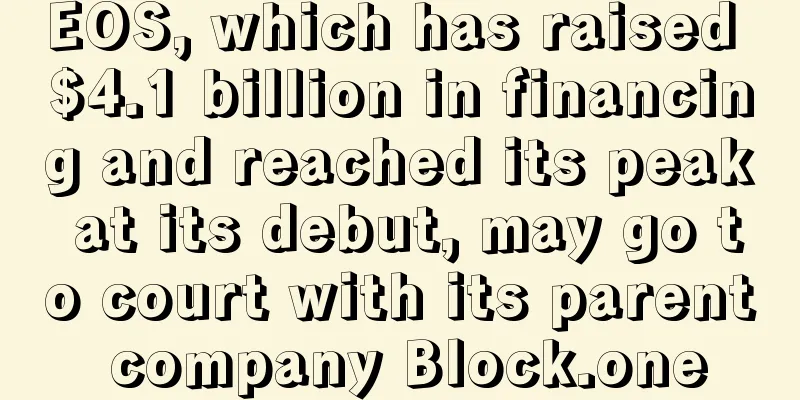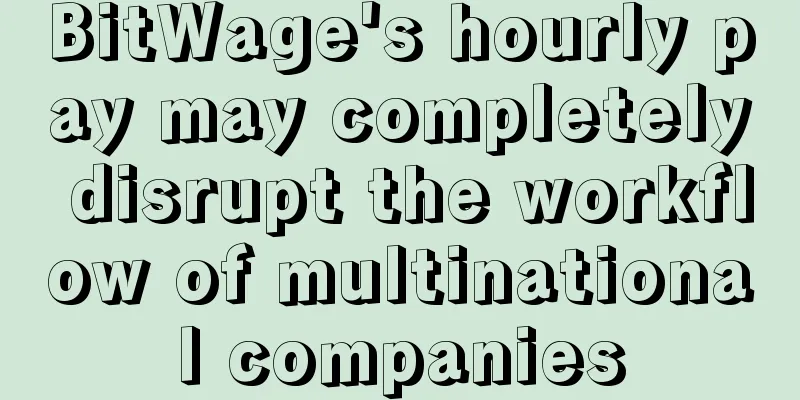EOS, which has raised $4.1 billion in financing and reached its peak at its debut, may go to court with its parent company Block.one

|
In 2018, EOS raised a record $4.1 billion in its one-year initial coin offering (ICO), and was once synonymous with replacing Ethereum as the center of the future DApp universe. But soon, the star of the year became a yesterday's flower that is only half-breathed today. In 2020, some researchers from Imperial College London analyzed EOS, Ripple and Tezos in an article published. They found that 95% of the transactions were triggered by the airdrop of EIDOS tokens. In other words, 95% of the transactions on the network are zero-value transactions. Just this Thursday, Yves La Rose, CEO of the EOS Network Foundation, said on Twitter that he was considering taking legal action against Block.one, the parent company of the EOS project, but this is not the first time that the EOS community has criticized Block.one. As early as 2019, when the U.S. Securities and Exchange Commission (SEC) fined Block.one, the parent company behind EOS, $24 million for failing to register an ICO, token holders tried to sue Block.one, calling the ICO sale a "fraudulent scheme" and claiming that the company deceived investors through "false and misleading statements about EOS" and that the project had artificially raised the price of EOS, violating security laws. But the lawsuit was eventually dropped. Back to the EOS project itself, this project is the best synonym for peaking at its debut. It performed well on the first anniversary of the mainnet launch, but has been going downhill since then. With the continuous decline in the price of the currency and the inaction of its parent company Block.one, many EOS ecosystem stakeholders are increasingly dissatisfied. The word EOS may be familiar to many people, but the company behind it, Block.one, is less well known. The reason why EOS has come to where it is today is largely due to Block.one. Block.one is a software company. Founded specifically for EOS development. A major contributor to EOSIO software development. Its co-founder and CTO Dan Larimer, referred to as BM in the industry, is a developer who is as famous as Ethereum's Vitalik Buterin. As famous as BM is Block.one's CEO, Brendan. A genius who started his own business at the age of 15. At that time, Brendan specialized in selling virtual assets in role-playing games (MMORPGs), and later his company was acquired. Brendan said that he started investing in cryptocurrencies around 2016, and then gradually developed a strong interest in its underlying blockchain technology. It is not just ordinary users who support EOS. Weiss Ratings, a cryptocurrency rating agency, once said: "EOS is still one of our highest-rated projects. However, due to concerns about its centralization, the EOS rating has been downgraded." Even Sam Englebardt, head of strategic partnerships at the well-known investment company Galaxy Digital, has publicly stated: “There are so many new blockchain projects on the market that it is difficult to determine which ones will become market leaders. However, we believe that EOS.IO is one of them. However, such a "dark horse" favored by both retail investors and institutions was eventually dragged down and turned into an "old horse" by its parent company. After many senior developers who created the original EOSIO code eventually chose to leave Block.one (including Daniel Larimer and other original core contributors) and chose to rejoin the EOS community in another way, the decline in Block.one's work efficiency became an inevitable result, and the few senior developers who remained at Block.one were reassigned to work on Bullish. In addition to the brain drain, all the expectations of the EOS community have been dashed over the past few years, and Block.one still has a lot of unfulfilled promises:
Eventually, the community's tolerance completely turned into anger, leading to Yves La Rose's words on Thursday, "Block.one is responsible for its past actions and broken promises. It is reviewing all possible legal means to seek $4.1 billion in damages." La Rose also wrote in a blog post that the foundation has invited a Canadian law firm to investigate Block.one's behavior and commitments to the EOS community and investors to determine whether there are options for legal action. As for how this love-hate relationship between lovers will play out, no one knows, but one thing is certain: in this war of attrition with capital, EOS may find it difficult to spare the energy to reproduce its former glory. For those investors who have waited for years in pursuit of their beliefs, Maybe it can only be that the work is not completed, the hair has turned gray, and the tears flow in vain. |
<<: ETH 2.0 gets a makeover, what impact will the June upgrade have?
>>: Methodology, tools and team: How to become a Web3 data analyst?
Recommend
What kind of face will make a woman lucky in marriage?
Women who are lucky in bringing good luck to thei...
People who like to use unfair means to achieve their goals
Being a human being should be upright and honest,...
Physiognomy analysis: What is the fate of people with flat noses? Do people with flat noses have good fortunes?
People with flat noses lack self-confidence In fa...
Is it good for a woman to have a mole on her forehead? What does a mole on her forehead mean?
The moles on a woman’s face will have an impact o...
Is it better for a woman to have hard hands or soft hands? Is it better for a woman to have soft hands or hard hands?
There is an old saying that women who are soft-he...
How to tell which women are destined to be unhappy?
If you want to have a happy relationship, it requ...
The personality of a man with linked eyebrows is that he hates evil but is easily impulsive.
What is the fate of men with unibrows? Connected ...
Freecash(FCH) lays the foundation for the crypto economy with the help of CryptoSignature 2.0
FreeCash lays the foundation for the crypto econo...
NYDIG Partners with Houston Rockets to Pay Royalties in Bitcoin
New York Digital Investment Group (NYDG) will use...
Are people with four white eyes only interested in profit? Is the quality good?
In fact, everyone has different qualities. If we ...
How will miners’ profits be solved if the Lightning Network becomes widely popular?
On December 7, 2018, Bitcoinist reported that the...
What kind of palmistry indicates a successful career
Whether in the feudal ancient times or in today&#...
SW soft fork upgrade implemented, Litecoin Global Roundtable Forum meeting announcement released
Today, the Litecoin community miners, mining pool...
What does it mean when the love line is broken? What does it mean when it is broken at different positions?
Is it true that every relationship of people with...
Revealing the secrets of a woman's fortune in an unhappy marriage based on her face
A woman's fortune can be seen slowly by looki...









